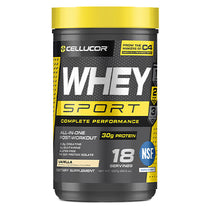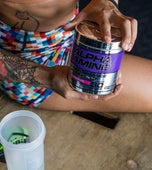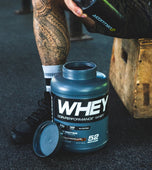
Ever wonder how some athletes seem to be able to peak at just the right time. Whether it’s hoisting up a massive deadlift or being able to zoom past the competition on race day. Chances are many of these athletes performing these impressive feats have followed a periodized training program.
Periodization is a training system that was popularized by coaches in the Soviet Union while preparing athletes for the Olympics. Since then, periodization has been widely adopted by coaches globally as a structured way to design training programs for their athletes to peak at specific times of the year.
We’re going to cover what periodization training is, the benefits associated with it, the different types of periodization training and phases that exist and cover why periodization training is recommended by so many different coaches.
What is Periodization?

Periodization is the systematic design of a training plan with the goal of peaking performance during specific dates during the year. Periodization involves implementing phases tailored to developing specific aspects of fitness while managing load to prevent overtraining.[1]
The concept behind periodization is rooted in research done by an endocrinologist Hans Seyle. It’s based on the principle of General Adaptation Syndrome (GAS). GAS is a concept that as a system is exposed to stress, a temporary decrease in performance occurs followed by a return to levels above initial fitness levels. This adaptation is known as super-compensation compensation. However, if the stress applied to a system remains constant (intensity, volume, frequency), a system can accommodate this, and no further improvements occur.[2] To address this, periodized programs use variety to expose the body to different stressors.

The most common types of periodization programs include:
-
Linear (or Traditional): Linear periodization starts out with relatively low intensity and higher training volumes and progressively increases training intensity while reducing volume.
-
Reverse: Reverse periodization starts out with relatively high intensity and low training volumes and progressively reduces training intensity while increasing volume.
-
Undulating: Undulating periodization implements more frequent changes in training intensity and volume during a program than linear or reverse periodization models. Undulating periodization can be further subdivided into daily undulating periodization (DUP) and weekly undulating periodization (WUP). DUP implements undulations (changes in training intensity, volume, or exercise selection) daily. While WUP implements undulations on a weekly basis.
- Block: Block periodization breaks down a training program into distinct phases that promote specific fitness goals. Each training block promotes a specific goal that leads into the next block, which all contribute to a larger overall goal.
Periodization Cycles & Phase

Periodized programs can be broken down into distinct cycles including microcycles, mesocycles, and macrocycles. Periodization follows a sequential approach going from more general preparedness phases to sport-specific phases. The typical phases follow a sequence of preparation, peaking, competition, and active rest.[3] A benefit of these distinct phases is that a program can simultaneously provide consistent overloading and variety. As an example, the different mesocycles in a program can provide variety in exercise selection or intensity while the larger mesocycle focuses on a specific aspect of fitness to consistently overload.
- Microcycle – a short length cycle that lasts a 1 – 4 weeks. A series of microcycles make up a mesocycle.
- Mesocycle – a medium length cycle that lasts 2 –4 months. A series of mesocycles make up a macrocycle.
- Macrocycle – a long length cycle that lasts several months (4+) to a year.
Because periodization was initially developed for Olympic athletes, traditionally macrocycles were planned out years in advance.
Different Types of Periodization Goals

Whether you want to squat double your bodyweight or enter your first 5k, periodization training programs can be used for different types of fitness goals. Periodized training plans were initially developed for Olympic sports, however nowadays they’re often modified to fit a wider range of fitness goals. Some of the most common types of periodization goals include.
-
Hypertrophy: Hypertrophy aka muscle-building focused periodization plans focus on training cycles that maximize muscle growth. Generally, these programs will skip cycles focused on attributes like speed or power. Hypertrophy focused programs will often vary the rep range and weight intensities lifted during workouts and cycles because muscle growth can occur over a wide range of reps and weight intensities. Because volume plays such a significant role in influencing muscle growth, periodized hypertrophy programs generally focus on progressively increasing volume.
-
Strength: Strength based periodization programs focus on increasing someone’s absolute strength, generally for the purpose of increasing their 1RM (one rep maximum, the maximum amount of weight they can lift for one rep). Powerlifters that focus on the “big three” lifts (bench press, deadlift, squat) commonly follow periodized strength programs. These programs typically follow a basic structure where weights are lifted at a sub-maximal intensity for more reps during the early cycles and lifted gradually decrease the number of reps they do as the intensity of the weight gets progressively heavier during later cycles of the program.
-
Power: Power-based periodization programs focus on increasing the amount of weight someone can lift explosively. Generally, this type of training is done by athletes like Olympic Lifters and Shot Putters, whose sports rely on them being able to generate high levels of force very rapidly. These programs often have athletes build strength during early cycles and then focus on power during later cycles.
-
Sports Performance: Sports performance based periodization programs will vary. The different cycles focus on specific skills needed for each sport. These types of periodization programs are often the most challenging to design because multiple aspects of fitness like strength/power, speed/endurance, power/endurance are being developed. Block, classical, and undulating periodization systems are commonly used for sports performance-based programs.
- Endurance: Endurance-based periodization can focus on building aerobic or anaerobic endurance. This type of periodization can be used for both short and long-distance endurance sports. As well as for single sport (like a trail run) or multi-sport (like a triathlon) endurance sports. Generally, long-distance endurance periodization plans spend a significant portion of the program focused on low-intensity steady state training and incorporate brief phases of high intensity training.
Periodization Training Benefits

Research has shown periodized training programs to have beneficial effects on strength, power, and endurance compared to non-periodized training programs. [4,5] However, some studies have found no significant differences between periodized and non-periodized training for muscle growth when the total training volume is the same between the two programs.[6]
So, what are some benefits one may get from following a periodized training program?
-
Breaking Plateaus: A periodized training program may be able to help you break a plateau by. exposing your body to higher training intensities and greater specificity.
-
Increasing Strength Overtime: Research on periodized training programs show that they can be effective for increasing absolute and relative strength over time. Because of this periodized training programs are especially popular among strength athletes.
-
Sustaining Muscle: Some forms of periodization like undulating programs that include high volume training days can be effective for helping to sustain muscle.
Tips for including periodization in your fitness routine

- SMART Goals: Set specific, measurable, actionable, realistic goals. You should account for both short- and long-term goals you want to achieve. This will help you with picking what type of periodized program fits your needs.
- Create a macrocycle block: This schedule should cover your workout plan for several weeks. Incorporate the microcycles you’d want within this program.
- Think about your recovery: When designing your program, be sure to pay attention to the overall workload demands of your program relative to your other commitments in life (personal relationships, work, other responsibilities). Factor these things in and account for rest periods within your micro and macrocycles.
- Track progress regularly: Reassess your program at regular intervals to make any adjustments needed to your routine. This could mean changing the exercises, the intensity, or even the rest periods.
- Consider outside help: If you’ve never created your own workout program before, you may want to get outside help from a personal trainer or coach. Even if you don’t use them as a source for creating your entire program, it can be helpful to have another set of eyes review your plan.
Supplements Made for Periodization

Supplements can be used during a periodized training program to further help support performance, hydration and recovery. You can even choose to align the supplements you use to match specific phases of your periodized program like fat loss or sports performance. One of the advantages of our Cellucor and XTEND family of products is that we even have NSF Certified for Sport offerings which is helpful for athletes that play competitive sports. Here’s an overview of some supplements that you could use alongside your periodized training program.
Pre-Workout
Pre-workout can help support increased energy, muscular endurance, and performance.
C4 SuperSport: Supercharged to help drive your performance. With ingredients to support energy, hydration, and increased strength and power, C4 SuperSport helps you reach your goals – wherever they take you!
C4 Original: Our original pre-workout that started it all - C4 Original is built to take your energy, muscular endurance, and pumps to the next level.
C4 Ultimate: Formulated to fuel your ultimate workout, C4 Ultimate provides ingredients to support ultimate energy + alertness, pump + performance and muscular endurance
Protein Powder
Protein powder can help support muscle growth and recovery.
COR-Performance Whey: For nearly a decade, COR-Performance Whey has been setting the standard in delicious high-quality protein. With incredible gluten-free flavors and digestive enzymes in every serving, COR-Performance Whey continues to raise the bar with every scoop.
XTEND Pro: Featuring 25g of Whey Isolate and 7g total BCAAs per serving, XTEND Pro takes muscle repair and recovery to the next level. With delicious gluten-free flavors, and two third-party certifications, it's no wonder that XTEND Pro is the protein choice of champions!
BCAA Powder
BCAA (branched chain amino acids) can help support muscle recovery and repair.
XTEND Sport: Featuring 7G BCAAs, a robust blend to support hydration, and proudly wearing the NSF Certified for Sport certification, XTEND Sport is the perfect solution for athletes both on and off the field.
XTEND Original: Formulated to support muscle recovery and hydration, XTEND Original provides 7G of BCAAs and hydrating electrolytes, all while delivering mouthwatering flavors with zero sugar - it's no wonder that XTEND Original has been the go-to recovery choice for over a decade.
Alpha Amino: Alpha Amino is the ultimate performance, hydration, and recovery sports drink powder. Whether you’re just starting out, or ready to reach that next level, Alpha Amino will support you throughout your entire journey. Be ready and recovered for whatever tomorrow brings.
Fat Burners
Fat burners commonly consist of thermogenic and stimulant ingredients, the purpose of including these ingredients in formulas is to increase thermogenesis (a process in the body which results in elevated body temperature which may lead to more caloric expenditure), energy, and alertness.
SuperHD: SuperHD is a dynamic formula with ingredients to help you look and feel your best. Including clinically studied ingredients to support weight loss plus added antioxidants, SuperHD has been the go-to for smooth energy & metabolism support for nearly a decade.
XTEND Ripped: XTEND Ripped features the clinically studied ingredient Capsimax, which helps support fat burning. In addition, XTEND Ripped is formulated without stimulants, giving you options for your workout routine.
References
[1] https://www.frontiersin.org/articles/10.3389/fphys.2019.01023/full
[2] https://journals.lww.com/nsca-jscr/fulltext/2015/04000/systematic_review_and_meta_analysis_of_linear_and.35.aspx
[3] https://www.fisiologiadelejercicio.com/wp-content/uploads/2017/05/Comparison-of-Periodized-and-Non-Periodized-Resistance.pdf
[4] https://www.researchgate.net/profile/Brandon-Alderman/publication/8058947_A_Meta-Analysis_of_Periodized_versus_Nonperiodized_Strength_and_Power_Training_Programs/links/570d5b2b08aed31341cf77a6/A-Meta-Analysis-of-Periodized-versus-Nonperiodized-Strength-and-Power-Training-Programs.pdf
[5] https://www.ncbi.nlm.nih.gov/pmc/articles/PMC6802561/
[6] https://link.springer.com/article/10.1007/s40279-021-01636-1





















